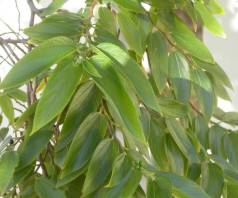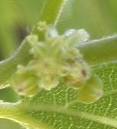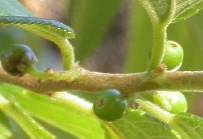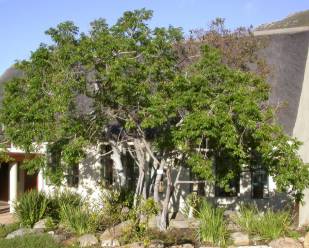Trema orientalis
Trema orientalis (L.) Blume
Family: Cannabaceae
Common names: trema, pigeon wood (Eng.); hophout (Afr.); umVumvu, umVangazi, uPhakane (Xhosa); umSekeseke, umBhangabhanga, ifamu, iphubane, isikhwelamfene, ubathini, umbokhangabokhanga, umcebekhazana, umdindwa, umvangazi (Zulu); umBalalaqane (Sw); mpukupuku (Tso); modutu (Northern Sotho), makuru-kuru (Venda)
SA Tree No: 42
Introduction
Trema orientalis is a fast-growing shade tree with soft foliage, best suited to gardens and streets in the warmer and wetter regions of southern Africa .

Description
Description
Depending on climatic conditions, trees may be evergreen or deciduous. In forests it is a straight, slender tree, up to 18 m on forest margins, and in the open it is wider-spreading, sometimes drooping, and in the KwaZulu-Natal bushveld it often grows as a shrub approx. 1.5 m tall. The less water it receives, the shorter it is.

Trema bark is smooth and light grey with conspicuous lenticels (corky spots).
The leaves are simple, alternate, stipulate although the stipules drop early, and usually 3-nerved from the base. It is quite difficult to distinguish its leaves from those of Celtis africana (white stinkwood), but they are usually bigger and more elongated. The leaf base is frequently unequal. Leaves taper from the base to the apex, and vary from 60 to 150 mm long and 25 to 50 mm wide. Leaf margins are finely serrated, and the young leaves are rough and hairy, occasionally becoming smooth when old.

Flowers are small, inconspicuous and greenish, carried in short dense bunches. They are usually unisexual, i.e. male and female are separate, occasionally they are found together. Flowers appear irregularly from late winter to autumn.

Fruits are small, round and green, becoming black when ripe. They are carried on very short stalks - this is the easiest way to tell this tree apart from the white stinkwood whose stalks are up to 13 mm long.
Distribution and habitat
Distribution description
This tree has a very wide distribution, occurring from tropical Africa southwards to South Africa , and eastwards to southern Asia . The trees are found in the higher rainfall areas of eastern and northern South Africa , and do not occur south of the Kei River . It has been recorded from the Erongo Mountains in Namibia . It occurs in a variety of habitats, and is usually found in moist soils at forest margins, along rivers and streams, often in riverine fringe thicket, also in ravines and valleys and along dry river beds.
Derivation of name and historical aspects
History
The name Trema is based on the Greek word for hole and alludes to the pitted stone of the fruit. The common name pigeon wood is derived from the fact that pigeons are frequently seen nesting or roosting in these trees.
There are about 50 shrubs or trees in the genus Trema , widely distributed in tropical and subtropical regions of the world. In South Africa there is only one species: Trema orientalis.
Ecology
Ecology
Flowers are pollinated by bees. Fruits are eaten by birds such as white-eyes, forest canaries and pigeons, and by fruit bats. Kudu and giraffe browse the foliage. At least 14 species of butterfly use Trema orientalis as a larval food plant. Pigeons are often seen nesting and roosting in these trees.
Uses
Use
The young leaves are eaten as a spinach by the Zulus, who also use the roots and bark as traditional medicine. Fruit, leaves, bark, stems, twigs and seeds are used in traditional medicine in West Africa , Tanzania , East Africa and Madagascar. In the forests of the Eastern Cape and KwaZulu-Natal, Trema orientalis is a common pioneer and forest-edge tree and is often used as traditional roof supports.
It is considered a desirable tree to have near the village, attracting large flocks of pigeons, which are hunted as food. Pegs made from the wood of Trema orientalis are often driven into the ground near fields to keep them from harm. An excellent string can be made from the bark. It was formerly used for tying assegaai heads to the shafts. Bark has also been used for waterproofing fishing lines. Handling of the tree sometimes causes eczema.
The wood is very light and somewhat stringy, pinkish in colour, and has not been used for much, except for things like brake-blocks for wagons in the old days, and fruit boxes.

Growing Trema orientalis
Grow
Trema orientalis is a common pioneer tree, seed germinates readily and growth is rapid. It's a good tree to plant in new empty gardens needing a tree to grow quickly. It's a good shade tree or street tree although not as tough and cold-hardy as Celtis africana (white stinkwood), it is better suited to the warmer and wetter parts of southern Africa . At Kirstenbosch, Trema was planted as a sheltering pioneer tree in the Arboretum, and within 10 years self-sown seedlings appeared.
Fresh seed germinates within few weeks, and seedlings are best kept damp and shaded. Transplant the young trees during cool and wet periods. Roots that are damaged mechanically often send up adventitious shoots, which can be cut off and transplanted as independent trees. Cuttings may be successful but have not been tried in the nursery.
References
- Coates Palgrave, K. 1977. Trees of southern Africa , edn 1. Struik, Cape Town , Johannesburg .
- Hutchings, A. 1996. Zulu medicinal plants, an inventory . University of Natal Press, Pietermaritzburg.
- Palmer, E. & Pitman, N. 1972. Trees of southern Africa . Balkema, Cape Town .
- Smith , C.A. 1966. Common names of South African plants. Memoirs of the Botanical Survey of South Africa No. 35. Department of Agricultural Technical Services, Pretoria .
- Van Wyk, P. & Van Wyk, B. 1997. Field guide to the trees of southern Africa . Struik, Cape Town .
Credits
Christien Malan and Alice Notten
Kirstenbosch National Botanical Garden
April 2005
Plant Attributes:
Plant Type: Tree
SA Distribution: Eastern Cape, KwaZulu-Natal, Limpopo, Mpumalanga, North West
Soil type: Sandy, Loam
Flowering season: Sporadic/All year
PH: Acid, Neutral
Flower colour: Green
Aspect: Full Sun, Morning Sun (Semi Shade), Afternoon Sun (Semi Shade)
Gardening skill: Easy
Special Features:
Horticultural zones











Rate this article
Article well written and informative
Rate this plant
Is this an interesting plant?
Login to add your Comment
Back to topNot registered yet? Click here to register.